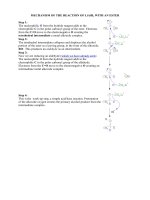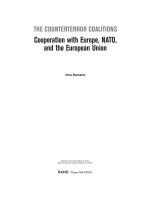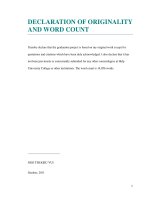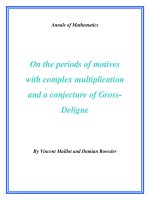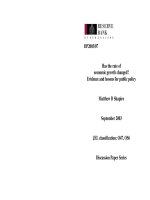Study the relationship of BCS with milk composition and reproductive performance
Bạn đang xem bản rút gọn của tài liệu. Xem và tải ngay bản đầy đủ của tài liệu tại đây (179.65 KB, 8 trang )
Int.J.Curr.Microbiol.App.Sci (2019) 8(1): 228-235
International Journal of Current Microbiology and Applied Sciences
ISSN: 2319-7706 Volume 8 Number 01 (2019)
Journal homepage:
Original Research Article
/>
Study the Relationship of BCS with Milk Composition and
Reproductive Performance
Budhi Prakash Meena, Subhash Chander Goswami, Vijay Kumar, Arun Kumar
Jhirwal, Vikramjit Singh* and Vikas Sharma
Department of Livestock Production Management,
College of Veterinary and Animal Science, Rajasthan University of Veterinary and Animal
Sciences, Bikaner-334001, Rajasthan, India
*Corresponding author
ABSTRACT
Keywords
Reproductive
performance, Kankrej,
Significantly,
Lactation, BCS
Article Info
Accepted:
04 December 2018
Available Online:
10 January 2019
A total of 18 Kankrej cattle of 1st to 4th parity were selected for the study and distributed
into three different groups based on their pre calving BCS (before 15 days of expected date
of calving) namely G1(2.50 - 3.00), G2 (3.25 - 3.75) and G3 (4.00 and above) with six
animals in each group. The average fortnight fat % in G1 was decreased up to 60 th day,
remained same up to 75th days and thereafter decreased, in G2 group decreased
significantly (P<0.05) up to 60th day and again increased up to 90th day, where as in G3
group increased significantly (P<0.05) up to 60 th day and then decreased up to 90th day.
The average lactose % was 4.40±0.09in G3 group which were highest followed by in G2
and G1 group 4.27±0.009 and 4.19±0.009, respectively. The average TS content of milk
changes with advance in lactation in G1 and G2 group animals, and were found to be non
significant throughout the study period. The animals of G2 BCS group had shorter
postpartum estrus period, a fewer services per conception, higher first service conception
rate and a shorter service period followed by Kankrej cattle of G3 group and GI group. The
studied revealed that BCS had a significant (P<0.05) effect on the reproductive
performance in experimental animals.
Introduction
In early lactation the energy intake does not
keep pace with continuously rising milk yield
as a result energy deficit increases. This leads
to a competitive situation among milk yield,
fertility and health of the dairy cow because
these traits are linked with energy requirement
(Coenen, 2014). The various blood
metabolites are used to measures the energy
balance (EB) status in dairy animals, which
has been reported to be strongly correlated
with energy balance (Konigsson et al., 2000
and Clark et al., 2005). However, analyses of
these blood metabolites are only feasible on
experimental farms. Therefore, there is
interest in other traits, which could serve as
indicators of EB and may subsequently be
related to the production and fertility status of
an animal. Body condition score (BCS) is one
228
Int.J.Curr.Microbiol.App.Sci (2019) 8(1): 228-235
of those 2 measures which is widely used in
many species to assess body composition and
energy status of animals (de Vries and
Veerkamp, 2000 and Veerkamp et al., 2001).
Materials and Methods
First service conception rate
The first service conception rate was
calculated by the percentage of experimental
cattle conceiving out of the total cattle at first
service.
Experimental design: Eighteen Kankrej
cattle were distributed into three separate
groups based on their pre-calving BCS (15
days before expected date of calving) namely
G1, G2 and G3 with six animals in each group
as shown in Table 1.
Analysis of data
Parameters to be studied
Milk composition
Milk components
The collected and tabulated data was analyzed
by using SPSS 20.0.
Results and Discussion
Fat (%)
The milk components, including fat, protein,
lactose, total solids and Solid Not Fat (SNF),
were studied in relation to BCS from calving
to12 weeks postpartum at weekly intervals.
The representative milk samples were
collected from the milking bucket after
complete milking of the individual animal.
The milk samples were analyzed by auto
analyzer.
Reproductive parameter
Post partum estrus
Post Partum estrus was observed by the
acceptance of a male by the female, which is
the most prominent and reliable symptoms of
estrus.
Service period
The service period was calculated from the
date of calving to date of successful service.
The fortnight average fat per cent in milk of
animals of each group are presented in the
Table 2.
The average fortnight fat per cent in milk was
decreased up to 60th day and remained same
up to 75th day and thereafter increased up to
90th day in G1 group of animals, which was
found significantly from 15th to 45th day,
thereafter non-significant up to 90th day.
The average fortnight fat per cent in milk of
G2 group of animals, decreased up to 60th day
but significantly (P<0.05) up to 30 and
increased up to 75th day and again decreased
up to 90th day, which was found to be non
significant.
The average fortnight fat per cent in milk of
G3 group animals, decreased significantly
(P<0.05) up to 60th day then after decreased up
to 90th day which was found to be non
significant.
Number of service per conception
The data regarding number of service per
conception was obtained from the record of
the farm.
The average fat per cent significantly (P<0.05)
differed between the G1 and G2, G3 groups
throughout the study period. There was G2
and G3 group non-significant throughout the
229
Int.J.Curr.Microbiol.App.Sci (2019) 8(1): 228-235
study period. The G3 and G2 group animals
had the highest fat percent in the milk
followed by G1 group animal 3.54±0.07,
3.86±0.068 and 3.86±0.065%, respectively.
reported by Prasad and Tomar (1996),
Musthaq (2010) in Nili Ravi buffalo and Janus
et al., (2012) in H.F. cows.
Protein (%)
Similar finding were reported by Prasad and
Tomar (1996). Berry et al., (2007), Musthaq
(2010) in Nili Ravi buffalo, Janus et al.,
(2012) in H.F. cow, and Singh et al., (2015) in
H.F. cows.
The fortnight average protein per cent in milk
of Kankrej cattle with different BCS groups
are presented in Table 4.
The average fortnightly Solid Not Fat per cent
in milk of Kankrej cattle with different BCS
groups are presented in Table 3.
The average fortnight protein per cent in milk
of G1 group of animals increased up to 45th
day and thereafter decreased up to 60th day,
and after that there was gradual increase in
protein per cent up to 90th day, which were
found to be non significant.
The average fortnight SNF percent in the milk
of G1 group animals was found significant
between 45th to 60th days and G2 group
animals was found to be non significant
throughout the study period except 30th and
45th days.
The fortnight average protein per cent in milk
of G2 group animals increased up to 30th day
and thereafter decreased up to 60th day then
again increased up to 75th day after that
remained same up to 90th day, which were
found to be non significant.
The average fortnight SNF per cent in milk of
G3 group animals, decreased up to 90th day,
which was found to be non significant
throughout the study period except 15th, 30th
and 45th day. .
The fortnight average protein per cent milk of
G3 group animals, increase significantly
(P<0.05) up to 60th day, and afterward
decreased up to 75thday and remained same up
to 90th day.
The fortnight average SNF per cent were
found to be significant between the groups in
45th days of lactation, thereafter G1 and G2
group was found to be non significant in
between group but both groups were
significant with G3 group.
There was significant (P<0.05) difference in
fortnight average protein percent between the
three groups throughout the study period. The
average protein per cent was 3.60±0.05 in G3
group which were highest followed by
3.32±0.05 and 3.16±0.05, respectively in G2
and G1 group.
Solid Not Fat % (SNF %)
There was significant (P<0.05) difference in
fortnight average SNF percent between the
three groups throughout the study period.
In G3 group of animals the SNF per cent was
8.74±0.05 which was highest among all the
groups and in the G2 and G1 group of animals
the corresponding values were 8.67±0.05 and
8.61±0.05, respectively. Similar findings were
Similar findings were reported by Prasad and
Tomar (1996), Musthaq (2010) in Nili Ravi
buffalo, Janus et al., (2012) in H.F. cows.
However, Treacher et al., (1986) reported that
during early lactation, the group of fat (BCS
4) cows had yielded less milk protein than the
group of thin (BCS 2.5) cows which is in
disagreement with present study.
230
Int.J.Curr.Microbiol.App.Sci (2019) 8(1): 228-235
Lactose (%)
The fortnight average lactose per cent in milk
of Kankrej cattle with different BCS groups
are presented in Table 5.
The average fortnightly lactose per cent in
milk of G1 group of animals decreased up to
30th day and afterward increased up to 60th day
and then again decreased up to 90th, which
was found to be non significant. The average
fortnightly lactose percent in milk of G2 group
of animals, decreased up to 30th day and
afterward increased up to 60th day and
decreased up to 75th day afterward remain
same up to 90th day, which was found to be
non significant.
Table.1 Grouping of the cattle based on their pre-calving BCS
Grouping of the cattle based on No. of animals
their pre-calving BCS Groups
6
G1
6
G2
6
G3
BCS
2.50 - 3.00
3.25 - 3.75
4.00 and above
Table.2 Average fortnightly fat (%) in milk of Kankrej cattle with different BCS groups
Fortnight
Intervals (days)
15
30
45
60
75
90
Total (Average)
Average Fat (%) of animals in BCS groups
G1
G2
G3
aC
bC
cD
3.71 ±0.01
3.97 ±0.02
4.13 ±0.01
aB
bB
3.55 ±0.03
3.90 ±0.05
4.01cC±0.06
3.51aA±0.02
3.86bAB±0.06
3.83bB±0.05
3.50aA±0.02
3.83bA±0.04
3.77cA±0.06
3.50aA±0.02
3.84bA±0.05
3.74cA±0.04
aAB
bA
3.52 ±0.01
3.82 ±0.04
3.72cA±0.04
3.54a±0.07
3.86b±0.068
3.86b±0.065
Different superscript in a column (capital letter A, B, C) differ significantly (p<0.05),
Different superscript in a row (small letter a, b, c) differ significantly (p<0.05).
Table.3 Fortnightly average solid not fat (%) in milk of Kankrej cattle with different BCS groups
Fortnight
Intervals (days)
15
30
45
60
75
90
Total (Average)
Average SNF (%) of animals in BCS groups
G1
G2
G3
aA
bA
cC
8.60 ±0.01
8.70 ±0.01
8.77 ±0.01
aA
bB
8.60 ±0.03
8.70 ±0.04
8.76cBC±0.02
8.57aA±0.04
8.68bAB±0.05
8.74cAB±0.02
8.64aB±0.03
8.66aAB±0.04
8.73bA±0.02
aB
aA
8.65 ±0.03
8.66 ±0.05
8.72bA±0.02
8.66aC±0.03
8.66aA±0.05
8.71bA±0.02
8.61a±0.05
8.67b±0.05
8.74c±0.05
Different superscript in a column (capital letter A, B, C) differ significantly (p<0.05),
Different superscript in a row (small letter a, b, c) differ significantly (p<0.05)
231
Int.J.Curr.Microbiol.App.Sci (2019) 8(1): 228-235
Table.4 Fortnightly average Protein (%) in milk of Kankrej cattle with different BCS groups
Fortnight
Intervals (days)
15
30
45
60
75
90
Total (Average)
Average Protein (%) of animals in BCS groups
G1
G2
G3
aA
bA
cA
3.14 ±0.01
3.30 ±0.01
3.54 ±0.01
3.15aA±0.02
3.34bA±0.02
3.57cA±0.03
3.17aA±0.02
3.32bB±0.01
3.62cA±0.05
aAB
bAB
3.16 ±0.01
3.30 ±0.01
3.64cB±0.04
3.17aA±0.02
3.34bA±0.02
3.63cB±0.04
3.20aAB±0.02
3.34bAB±0.02
3.63cB±0.05
3.16a±0.05
3.32b±0.05
3.60c±0.05
Different superscript in a column (capital letter A, B) differ significantly (p<0.05),
Different superscript in a row (small letter a, b, c) differ significantly (p<0.05)
Table.5 Fortnightly average Lactose (%) in milk of Kankrej cattle with different BCS groups
Fortnight
Intervals (days)
15
30
45
60
75
90
Total (Average)
Average Lactose (%) of animals in BCS groups
G1
G2
G3
4.20aA±0.01
4.29bA±0.01
4.47cB±0.01
4.19aA±0.03
4.27bA±0.02
4.45cB±0.01
aA
bA
4.20 ±0.03
4.28 ±0.02
4.43cB±0.01
4.21aA±0.02
4.29bA±0.02
4.48cB±0.01
4.20aA±0.02
4.27bA±0.02
4.45cB±0.02
4.18aA±0.02
4.27bA±0.02
4.17cB±0.02
a
b
4.19 ±0.009
4.27 ±0.009
4.40c±0.09
Different superscript in a column (capital letter A, B, C) differ significantly (p<0.05),
Different superscript in a row (small letter a, b, c) differ significantly (p<0.05)
Table.6 Average fortnightly total solid (%) in milk of Kankrej with different BCS groups
Fortnight
Intervals (days)
15
30
45
60
75
90
Total (Average)
Average Total solids (%) of animals in BCS groups
G1
G2
G3
aC
bD
12.3 ±0.01
12.66 ±0.02
12.89cD±0.01
aB
bC
12.15 ±0.02
12.60 ±0.02
12.76cC±0.02
12.07aB±0.01
12.53aA±0.02
12.56aA±0.02
12.14aB±0.01
12.49bA±0.01
12.49bA±0.08
aB
bA
12.14 ±0.01
12.49 ±0.02
12.45cA±0.01
12.17aB±0.01
12.47bA±0.02
12.42bA±0.01
12.16a±0.01
12.54b±0.01
12.60c±0.03
Different superscript in a column (capital letter A, B, C, D) differ significantly (p<0.05),
Different superscript in a row (small letter a, b, c) differ significantly (p<0.05)
232
Int.J.Curr.Microbiol.App.Sci (2019) 8(1): 228-235
Table.7 The reproductive performances in Kankrej cattle with different BCS groups
S.No.
1.
2.
3.
4.
Reproductive traits
Post-partum estrus
(days)
No. of service per
conception
BCS groups
G1
102 ±3.91
G2
66.67 ±1.62
G3
83.17 ±1.83
2.17b±0.30
1.34a±0.21
1.50a±0.22
66.67b±21.08
50.00b±22.36
91.34a±4.11
114.67b±3.48
c
First service conception 16.67a±16.66
rate (%)
Service period (Days)
147.5c±7.36
a
b
Different superscript in a row (small letter a, b, c) differ significantly (p<0.05)
In G3 group of animals, the average fortnight
lactose percent in milk decreased up to 45th
day and afterward increased up to 60th day
afterward again decreased up to 90th day,
which was found to be non significant.
G1 and G2 group of animals, and were found
to be non significant throughout the study
period.
The fortnight average TS per cent in milk of
G3 group of animals decreased up to 90th day,
but the decrease was significant (P<0.05) up
to 45th day.
There was significant (P<0.05) difference in
fortnight average lactose percent between the
three groups throughout the study period. The
average lactose % was 4.40±0.09 in G3 group
which were highest followed by in G2 and G1
group 4.27±0.09 and 4.19±0.09, respectively.
There was significant (P<0.05) difference in
TS per cent in the milk of G1, G2 and G3
groups throughout the study period. The
average TS per cent were 12.60±0.03 % in G3
group animals which were highest followed
by in G2 and G1 group with 12.54±0.01%
and 12.16±0.01%, respectively.
Similar findings were reported by Musthaq
(2010) in Nili Ravi Buffalo, and Janus et al.,
(2012) in H.F. cows
However, Treacher et al., (1986) reported that
during early lactation, the group of fat (BCS
4) cows had yielded less lactose than the
group of thin (BCS 2.5) cows which is in
disagreement with present study.
Similar findings were reported by Janus et al.,
(2012).
Reproductive performance
The reproductive performances in Kankrej
cattle with different BCS groups are presented
in Table 7.
Total solid (%)
The fortnight average total solids per cent in
milk of Kankrej cattle with different BCS
groups are presented in Table 6. The fortnight
average total solids differ significantly
(P<0.05) in milk of Kankrej cattle among
different BCS groups. The average TS content
of milk changes with advance in lactation in
Table revealed that the animals of G2 group
had shorter postpartum estrus period, fewer
services per conception, higher first service
conception rate and shorter service period and
the values for corresponding parameter were
66.67±1.62 days, 1.34a±0.21, 66.67 per cent
233
Int.J.Curr.Microbiol.App.Sci (2019) 8(1): 228-235
and 91.34±4.11 days, respectively. The
Kankrej cattle of G3 group had 83.17±1.83
days, 1.50±0.22, 50.00 percent and
114.67b±3.48 respectively for post-partum
estrus, number of service per conception, first
service conception rate and service period.
Whereas Kankrej cattle of G1 group had
102±3.91days, 2.17±0.30, 16.67 per cent and
147.5±7.36 days respectively for post-partum
estrus, number of service per conception, first
service conception rate and service period.
The study revealed that BCS had significant
(P<0.05) effect on all the reproductive traits
under the study.
effects on milk production in Irish
Holstein-Friesian dairy cows. Animal.
1(9): 1351-1359.
Clark, C. E. F., Fulkerson, W. J., Nandra, K.
S., Barchia, I. and Macmillan, K. L.
2005. The use of indicators to assess the
degree of mobilization of body reserves
in dairy cows in early lactation on a
pasture-based
diet.
Livestock
Production Science. 94: 199-211.
Coenen, H. and Peter, M. S. 2014.
Associations among body condition
score, body weight, and milk weight in
crossbred dairy cattle in a confined
dairy
operation.
Tarleton
State
University.
DeVries, M. J. and Veerkamp, R. F. 2000.
Energy balance of dairy cattle in
relation to milk production variables
and fertility. Journal of Dairy Science.
83:62–69.
Gillund, P., Reksen, O., Grohn, Y. T. and
Karlberg, K. 2001. Body condition
related to ketosis and reproductive
performance in norwegian dairy cows.
Journal of Dairy Science. 84(6): 1390–
1396.
IBM SPSS STATISTICS VERSION; 20.
Janus, E. and Borkowska, D. 2012. Changes
of body condition of cows, daily milk
yield and its composition during the
course of lactation. Rocz Nauk. 1(1): 7584.
Konigsson, K., Savoini, G., Govoni, N.,
Invernizzi, G., Prandi, A., Kindahl. H.
and Veronesi, M. C. 2000. Energy
balance, leptin, NEFA and IGF-I
plasma concentrations and resumption
of postpartums ovarian activity in
Swedish red and white breed cows. Acta
Veterinaria Scandinavica. 50(3): 1-7.
Mushtaq, A. 2010. Effect of Physiological
states on milk fatty acids profile In
dairy cows and buffaloes. Ph.D. Thesis,
(Livestock
production
and
management), North-West Frontier
Similar findings were reported by Gillund et
al., (2001) in Norvegian cattle, Buckley et al.,
(2003) in H.F. cows, Rochey et al., (2009), in
dairy cow, Bayram et al., (2008) in Swedish
Red and White cows, Rao and Anitha (2013)
in buffalo and Stadnik et. al., (2017) in Czech
Fleckvieh cows.
Acknowledgement
The authors thankfully acknowledged the
financial support and facilities provided by
RAJUVAS, Bikaner to carry out the research
work.
References
Bayram, B., Yanar, M. and Akbulut, O. 2008.
Reproductive and milk production traits
of Holstein Friesian cows in pre-organic
and organic dairy husbandry in Turkey.
Journal of Animal and Veterinary
Advances. 7(7): 808-811.
Buckley, F., Sullivan, K., Mee, J. F., Evans,
R. D. and Dillon, P. 2003. Relationships
among milk yield, body condition, cow
weight, and reproduction in springcalved Holstein-Friesians. Journal of
Animal Science. 86(7): 2308-2319.
Berry, D. P. Buckley, F. and Dillon, P. 2007.
Body condition score and live-weight
234
Int.J.Curr.Microbiol.App.Sci (2019) 8(1): 228-235
Province,
Agricultural
University,
Peshawar.
Rao, K. S. and Anitha, A. 2013. Body
Condition Score (BCS) system in
Murrah buffaloes. Buffalo Bulletin. 32:
1290-1298.
Roche, J. R., Friggens N. C., Stockdale, C. R.,
Baumgard, L. H., VanBaale, M. H. and
Berry, D. P. 2009. Body condition score
and its association with dairy cow
productivity, health, and welfare.
Journal of Dairy Science. 92(12): 5769–
5801.
Singh, V., Singh, V. K., Singh, S. P. and
Sahoo, B. 2015. The effect of body
score condition at calving on milk yield,
milk composition and udder health
status of dairy animals. Journal of
dairy, Veterinary and Animal Research.
2(2): 22
Stadnik, L., Atasever, S. and Duchacek, J.
2017. Effects of body condition score
and daily milk yield on reproduction
traits of Czech Fleckvieh cows. Animal
Reproduction. 14(1): 1264-1269.
Thomas, C. K. and Sastry, N. S. R. 2012.
Dairy Bovine Production, 2nd revised
Edn., Kalyani Publishers, New Delhi,
India.
Treacher, R. J., Roberts, C. J. and Tomas, J.
1986. Effect of body condition on
reproductive performance in dairy
cows. Animal Production. 79: 11-16.
Veerkamp, R. F., Koenen, E. P. C. and
DeJong, G. 2001. Genetic correlations
among Body condition score, yield, and
fertility in 1st parity cows estimated by
random regression models. Journal of
Dairy Science. 84: 2327-2335.
How to cite this article:
Budhi Prakash Meena, Subhash Chander Goswami, Vijay Kumar, Arun Kumar Jhirwal,
Vikramjit Singh and Vikas Sharma. 2019. Study the Relationship of BCS with Milk
Composition and Reproductive Performance. Int.J.Curr.Microbiol.App.Sci. 8(01): 228-235.
doi: />
235
